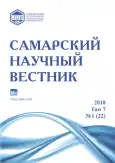Soil Algae and mosses role in biocenoses formation in the tailings of Mikhailovsky Mining and Beneficiation Plant of Kursk Magnetic Anomaly
- Authors: Nagornaya O.V.1, Golovastikova A.V.2
-
Affiliations:
- Kursk State Agricultural I.I. Ivanov Academy
- Kursk Institute of Cooperation (branch) of Belgorod University of Cooperation, Economics and Law
- Issue: Vol 7, No 1 (2018)
- Pages: 87-91
- Section: 03.02.00 – General Biology
- URL: https://journals.rcsi.science/2309-4370/article/view/25351
- DOI: https://doi.org/10.17816/snv201871116
- ID: 25351
Cite item
Full Text
Abstract
The paper presents the results of studies investigating the role of representatives of Algae and Bryophyta divisions in the composition of biocenoses dumps loess-like loam and clay of the Callovian of different ages (5-, 15-, 25 years) of Mikhailovsky Mining and Beneficiation Plant of Kursk Magnetic Anomaly. The author considers the role of soil Algae and mosses as indicators of biocenosis changes in connection with the peculiarities of the lithological framework and age of the dumps. It is proved that successione changes in communities of soil Algae and mosses coincide with succesional changes in the phytocenoses of the dumps in General. Studies have shown that the primary satelitales dumps are the representatives of the department of blue-green Algae Cyanophyta. They form a mono community in 5 year dumps clay of the Callovian and dominate in 5 year dumps. Further formation of the algae Alps in all types of studied rocks is of zonal type. The first of the mossy plants of the Bryophyta dumps division inhabits Ceratodon purpureus (Hedw.). It is the dominant species and persists on all breeds up to the age of 25 as the least demanding of the substrate. Further, the formation of the community of mosses is on a zonal type and lesavignon loam, on average, 15 years faster. It is found that algal communities and bryophytes cenoses form at different speeds on the soil stockpiles. It has been calculated that the stabilization of Algae cenoses will require about 19 years for the Quaternary loess and 32 years on the clay of the Callovian. Stabilization of the community of moss will require about 35 years for the loess and about 70 years on the clay of the Callovian.
Full Text
##article.viewOnOriginalSite##About the authors
Olga Vyacheslavovna Nagornaya
Kursk State Agricultural I.I. Ivanov Academy
Email: nagornayaov@yandex.ru
candidate of biological sciences, associate professor of Ecology, Horticulture and Plant Protection Department
Russian Federation, KurskAntonina Valentinovna Golovastikova
Kursk Institute of Cooperation (branch) of Belgorod University of Cooperation, Economics and Law
Author for correspondence.
Email: golovastikova.a.v@mail.ru
candidate of agricultural sciences, associate professor of Merchandising Disciplines Department
Russian Federation, KurskReferences
- Стриганова Б.Р. Питание почвенных сапрофагов. М.: Наука, 1980. 243 с.
- Штина Э.А. Почвенные водоросли как экологические индикаторы // Ботанический журнал. 1990. Т. 75, № 4. С. 441-453.
- Биология. В 3 т. Тейлор Д. [и др.] М., 2004. Т. 1. 454 с.
- Нешатаев Ю.Н. Методы анализа геоботанических материалов. М.: Изд-во МГУ, 1987. 192 с.
- Дылис Н.В. Программа и методика биогеоценотических исследований. М.: Наука, 1974. 404 с.
- Воронов А.Г. Геоботаника. М.: Высшая школа. 1973. 384 с.
- Колесников Б.П., Моторина Л.В. Методы изучения биогеоценозов в техногенных ландшафтах // Программа и методика изучения техногенных биогеоценозов. М.: Наука, 1978. С. 5-21.
- Определитель пресноводных водорослей СССР (12 выпусков) / под ред. М.М. Голлербах [и др.]. М.: Советская наука. 1951-1983.
- Штина Э.А. Методы изучения почвенных водорослей // Микроорганизмы как компонент биогеоценоза. М., 1984. С. 58-74.
- Савич-Любицкая Л.И. Верхоплодные мхи. М.: Наука, 1970. 826 с.
- Попов С.Ю. Иллюстрированный полевой ключ для определения наиболее распространенных листостебельных мхов лесной зоны центральной России. М., 2008. 41 с.
- Мельничук В.М. Определитель лиственных мхов средней полосы и юга Европейской части СССР. К.: Наукова думка, 1970. 444 с.
- Лукашин Ю.П. Адаптивные методы краткосрочного прогнозирования временных рядов. М.: Финансы и статистика, 2003. 416 с.
- Штина Э.А. Альгофлора старых промышленных отвалов Урала и ее роль в биологической рекультивации // Растения и промышленная среда. Свердловск, 1989. С. 56-66.
- Кабиров P.P., Пурина E.С., Сафиуллина Л.М. Почвенные водоросли: качественный состав, количественные характеристики, использование при проведении экологического мониторинга // Успехи современного естествознания. 2008. № 5. С. 38-39.
- Кабиров Р.Р. Роль почвенных водорослей в антропогенных экосистемах // Успехи современного естествознания. 2007. № 6. С. 12-15.
- Панкратова Е.М., Домрачева Г.И., Перлинова Г.И. Экспресс-метод определения биологического благополучия почв на базе фототрофных микроорганизмов // Рациональное использование земельных ресурсов России. Киров, 1993. С. 122-123.
- Кузяхметов Г.Г. Водоросли зональных почв степи и лесостепи // Почвоведение. 1991. № 9. С. 63-71.
- Стифеев А.И. Рекультивация земель и почвообразование в техногенных ландшафтах КМА: дис. … д-ра с/х. наук. Курск, 1993.
- Игнатов М.С., Игнатова Е.А. Флора мхов средней части Европейской России. М., 2003. Т. 1. 608 с.
- Коршиков И.И., Михеенко И.П., Тарабрин В.П. Перспективы использования мхов в рекультивации отвалов угольных шахт Донбасса // Проблемы рекультивации нарушенных земель: тезисы докладов V Уральского совещания. Свердловск, 1988. С. 117-118.
- Бойко М.Ф. Мохообразные начальных стадий первичных сукцессий на субстратах антропогенного происхождения // Экология. 1991. № 2. С. 21-26.
- Игнатов М.С., Игнатова Е.А. Флора мхов средней части Европейской России. М., 2011. Т. 1. 608 с.
Supplementary files







